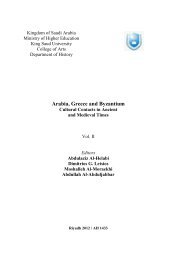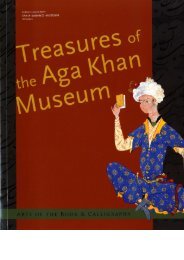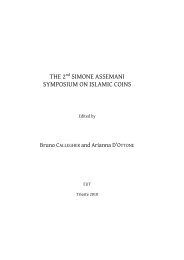ulum-al-quran
ulum-al-quran
ulum-al-quran
You also want an ePaper? Increase the reach of your titles
YUMPU automatically turns print PDFs into web optimized ePapers that Google loves.
known of the pre-Islamic Arab prosodies. It is distinct from poetry in its lack of metre, i.e. it has no consistent rhythmic<br />
pattern, and it shares with poetry the element of rhyme, [C<strong>al</strong>led fasila ( pl. fawasil) when used for the Qur'an] though in<br />
many cases somewhat irregularly employed.<br />
The Difference between Literature and the Qur'an<br />
Ibn Kh<strong>al</strong>dun (d. 809H/1406), the well-known author of the muqaddima pointed out in a passage on the literature of the<br />
Arabs the difference between literature and the Qur'an in gener<strong>al</strong> and between saj' and the Qur'an in particular:<br />
Examples:<br />
'It should be known that the Arabic language and Arab speech are divided into two branches. One of<br />
them is rhymed poetry ... The other branch is prose, that is, non-metric<strong>al</strong> speech ... The Qur'an is in<br />
prose. However, it does not belong in either of the two categories. It can neither be c<strong>al</strong>led straight prose<br />
nor rhymed prose. It is divided into verses. One reaches breaks where taste tells one that the speech<br />
stops. It is then resumed and "repeated" in the next verse. (Rhyme) letters, which would make that (type<br />
of speech) rhymed prose are not obligatory, nor do rhymes (as used in poetry) occur. This situation is<br />
what is meant by the verse of the Qur'an:<br />
'God reve<strong>al</strong>ed the best story, a book harmoniously arranged with repeated<br />
verses ...' (Al-Qur'an 39: 23).<br />
[Ibn Kh<strong>al</strong>dun: The Muqaddima, Princeton, 1967, Vol. 3, p.368; Ibn Kh<strong>al</strong>dun: Muqaddima, Cairo, n.d.,<br />
p.424.]<br />
A good example for a saj'-like passage in the Qur'an would be Sura <strong>al</strong>-ikhlas (112: 14). It is somewhat irregular in its<br />
rhythm, and it has a rhyme ending with the syllable "ad":<br />
Qul huwa llahu ahad Say: He is God the One and Only<br />
Alahus samad God the Etern<strong>al</strong>, Absolute<br />
Lam y<strong>al</strong>id wa lam yulad He begetteth not nor is He begotten<br />
wa lam yakun lahu kufuwan ahad And there is none like unto Him.<br />
Of the many passages more like plain prose, <strong>al</strong>though not quite identic<strong>al</strong> to it, as the kind of end-rhyme indicates, the<br />
following may serve as an example:<br />
'Inna auhaina ilaika kama We have sent thee inspiration as We sent it<br />
auhaina ila nuhin wa nabiyina to Noah and the messengers<br />
min ba'dihi wa auhaina ila after him: We sent inspiration to<br />
ibrahima wa isma'ila wa Abraham, Ismail,<br />
ishaqa wa ya'quba Isaac, Jacob<br />
wa-l-asbati wa 'isa wa ayyuba and the tribes, to Jesus, Job,<br />
wa yunusa wa haruna wa Jonah,Aaron, and<br />
sulaimana wa ataina dawuda Solomon, and to David<br />
Zabura. Wa rusulan qad we gave the Ps<strong>al</strong>ms. Of some apostles<br />
qasasnahum '<strong>al</strong>aika min We have <strong>al</strong>ready told thee<br />
qablu wa rusulan lam the story, of others<br />
naqsushum '<strong>al</strong>aika wa We have not.<br />
k<strong>al</strong>lama llahu musa taklima. And to Moses God direct spoke.





